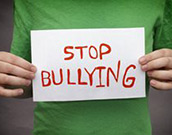|
|
 |
|
The views expressed on this page are soley
those of the author and do not
necessarily represent the views of County
News Online
|
 |
Start Talking!
Know! The End
of Bullying Begins With YOU
October is Bullying Prevention Month
10/11/2017
Wondering why we hear so much about bullying? Because there’s way too
much of it going on and it’s a huge problem for everyone involved.
Students report getting bullied most often because of looks, body
shape, race and sexual orientation. While every child is at risk for
being the target of bullying, young people with disabilities or special
education needs get bullied two to three times more often than their
peers. At the same time, children with disabilities are also at an
increased risk for bullying others as well.
In 2016, more than one in five students reported being bullied.
According to research, however, the majority of young people who are
bullied do not report it. And the older a student becomes, the less
likely he or she is to tell anyone – including peers – which is
especially bad news because peer intervention is so important.
More than half of all bullying situations come to a halt when a peer
steps in. We’re not talking stepping into the middle of a school fight
(in that situation you’d want to encourage your child to grab a teacher
to help). We’re talking about supportive actions, like befriending the
person being bullied, letting them know they are not alone or helping
them tell someone, like a school resource officer, teacher or school
counselor.
When it comes to a bullying situation, there is typically a target, a
bully and bystanders. Regardless of what position a child is in, the
consequences can be detrimental.
Youth who experience bullying are at an increased risk for poor school
performance, sleeping difficulties, low self-esteem, feelings of fear,
anxiety, depression and even suicidal thoughts.
Youth who engage in bullying are also at increased risk for academic
problems, in addition to a greater likelihood for substance use and
violent behavior during later adolescence and adulthood.
There is typically not a lot of sympathy for a person who bullies
others, but oftentimes, a child engages in such behavior due to peer
pressure, fear, insecurity, a lack of positive role models and
sometimes as a response to being bullied themselves. These do not
excuse the behavior, but may provide a better understanding of where
the behavior originates.
Youth who both engage in bullying and are the target of bullying
themselves are at the highest risk for a variety of mental health and
behavior problems.
Even witnesses of bullying experience negative consequences. They say
they feel less safe at school and report feelings that range from anger
to guilt to fear. They often want to help, but they don’t know how.
As parents, we need to be specific in telling our children:
It is never okay to hurt, harm or humiliate another person with your
words or behavior.
It is never okay for anyone to do this to you either; you deserve
respect, kindness and to feel safe.
If you experience bullying, please tell me or another trusted adult –
we can help make it stop
If you witness someone being bullied, do something – YOU can make a
difference!
Remember to follow Start Talking! on Twitter and Like us on Facebook.
Learn how to get the drug prevention conversation started at
StartTalking.Ohio.Gov.
|
|
|
|

